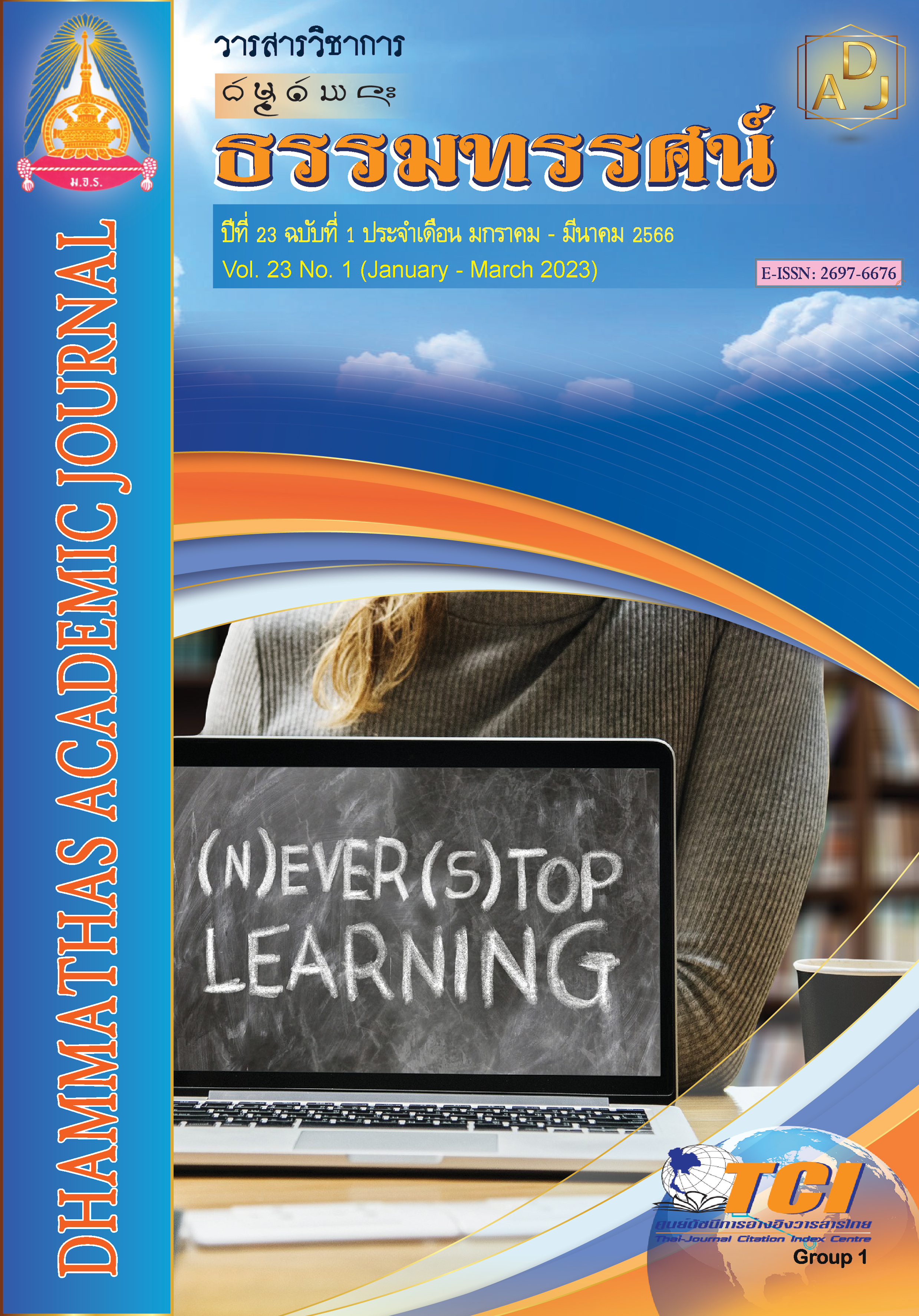การจัดการเศรษฐกิจสร้างสรรค์ของผลิตภัณฑ์ผ้าพื้นเมืองในถนนคนเดินเขมราฐ อำเภอเขมราฐ จังหวัดอุบลราชธานี
Main Article Content
บทคัดย่อ
การวิจัยครั้งนี้ มีวัตถุประสงค์เพื่อ 1) ศึกษาสภาพการจัดการเศรษฐกิจของผลิตภัณฑ์ผ้าพื้นเมือง อำเภอเขมราฐ จังหวัดอุบลราชธานี 2) ศึกษาการจัดการเศรษฐกิจสร้างสรรค์ของผลิตภัณฑ์ผ้าพื้นเมืองในถนนคนเดินเขมราฐ อำเภอเขมราฐ จังหวัดอุบลราชธานี 3) ศึกษาแนวทางการพัฒนาการจัดการเศรษฐกิจสร้างสรรค์ของผลิตภัณฑ์ผ้าพื้นเมืองในถนนคนเดินเขมราฐ อำเภอเขมราฐ จังหวัดอุบลราชธานี เครื่องมือที่ใช้เป็นแบบสัมภาษณ์ ผู้ให้ข้อมูลสำคัญ จำนวน 20 คน ใช้การสุ่มแบบเจาะจง และการปฏิบัติการเชิงพื้นที่ การวิเคราะห์ข้อมูลโดยการวิเคราะห์เนื้อหาเชิงพรรณนา
ผลการวิจัยพบว่า
1. สภาพการจัดการเศรษฐกิจของผลิตภัณฑ์ผ้าพื้นเมือง อำเภอเขมราฐ จังหวัดอุบลราชธานี มีการทอผ้าพื้นเมืองตามลายทอ องค์ความรู้ และภูมิปัญญาที่ได้รับการถ่ายทอดสืบกันมาจากรุ่นสู่รุ่น และมีการพัฒนาลายมาตามลำดับ เพื่อใช้สอยในชีวิตประจำวัน และในวาระพิเศษต่างๆ ซึ่งแสดงถึงอัตลักษณ์อันสะท้อนให้เห็นความงดงามของศิลปวัฒนธรรมของผู้คน ความเป็นอยู่ที่ได้รับความเอาใจใส่ผ่านเครื่องนุ่งห่มของชาวอำเภอเขมราฐ
2. การจัดการเศรษฐกิจสร้างสรรค์ได้มีการสร้างสรรค์ผลิตภัณฑ์ผ้าพื้นเมืองในถนนคนเดินเขมราฐให้เป็นที่รู้จักและเป็นที่ต้องตาตรึงใจของผู้ที่ได้พบเห็นผ่านการดำเนินกิจกรรมหลัก 2 กิจกรรม ได้แก่ 1) การจัดการท่องเที่ยวทางวัฒนธรรมของท้องถิ่นในอำเภอเขมราฐ จากอัตลักษณ์ทางวัฒนธรรมของชุมชนอำเภอเขมราฐ 2) การจัดกิจกรรมการจัดเดินแฟชั่นผ้าพื้นเมืองเขมราฐ
3. แนวทางการพัฒนาการจัดการเศรษฐกิจสร้างสรรค์ของผลิตภัณฑ์ผ้าพื้นเมืองในถนนคนเดินเขมราฐ ประกอบด้วย การอนุรักษ์ลายทอผ้าเดิมที่เป็นเอกลักษณ์ การออกแบบลายที่แปลกใหม่เพิ่มขึ้น การสืบทอดภูมิปัญญาการทอผ้าพื้นเมืองด้วยการบรรจุเนื้อหาภูมิปัญญาอย่างเป็นลายลักษณ์อักษร การเพิ่มช่องทางในการสืบทอดผ่านหน่วยงานภาครัฐ การออกแบบการตัดเย็บผ้าพื้นเมืองให้มีแบบที่ทันสมัย หลากหลาย การเพิ่มช่องทางการตลาดทั้งออนไซต์และออนไลน์ และการมีที่พักแบบโฮมสเตย์
Article Details

อนุญาตภายใต้เงื่อนไข Creative Commons Attribution-NonCommercial-NoDerivatives 4.0 International License.
เพื่อให้เป็นไปตามกฎหมายลิขสิทธิ์ ผู้นิพนธ์ทุกท่านต้องลงลายมือชื่อในแบบฟอร์มใบมอบลิขสิทธิ์บทความ ให้แก่วารสารฯ พร้อมกับบทความต้นฉบับที่ได้แก้ไขครั้งสุดท้าย นอกจากนี้ ผู้นิพนธ์ทุกท่านต้องยืนยันว่าบทความ ต้นฉบับที่ส่งมาตีพิมพ์นั้น ได้ส่งมาตีพิมพ์เฉพาะในวารสาร วิชาการธรรม ทรรศน์ เพียงแห่งเดียวเท่านั้น หากมีการใช้ ภาพหรือตารางของผู้นิพนธ์อื่นที่ปรากฏในสิ่งตีพิมพ์อื่นมาแล้ว ผู้นิพนธ์ต้องขออนุญาตเจ้าของลิขสิทธิ์ก่อน พร้อมทั้ง แสดงหนังสือที่ได้รับการยินยอมต่อบรรณาธิการ ก่อนที่บทความจะได้รับการตีพิมพ์เอกสารอ้างอิง
จักรพันธ์ โสมะเกษตริน. (2551). การจัดการภูมิปัญญาท้องถิ่นศรีสะเกษเพื่อการแข่งขันอย่างยั่งยืน. กรุงเทพฯ: สำนักงานการวิจัยแห่งชาติ.
นภาภรณ์ หะวานนท์ และพิสมัย รัตนโรจน์สกุล. (2548). ผลการวิจัยการเสริมสร้างทุนทางสังคมเพื่อชุมชนเข้มแข็ง. กรุงเทพฯ: สำนักงานคณะกรรมการเศรษฐกิจและสังคมแห่งชาติ.
ประเวศ วะสี. (2530). การศึกษาชาติกับภูมิปัญญาท้องถิ่น ในการสัมมนาทางวิชาการเรื่องภูมิปัญญาชาวบ้านกับการดำเนินงานด้านวัฒนธรรมกับการพัฒนาชนบท. กรุงเทพฯ: สำนักงานคณะกรรมการวัฒนธรรมแห่งชาติ.
ลักขณา ศิริจำปา. (2561). ปัจจัยที่มีอิทธิพลต่อการตัดสินใจซื้อผ้าฝ้ายย้อมสีธรรมชาติในเขตอำเภอเมือง จังหวัดกาฬสินธุ์. วารสารวิชาการ คณะวิทยาการจัดการ มหาวิทยาลัยราชภัฏมหาสารคาม, 3(6), 7-17.
วีรนันท์ พาวดี. (2558). ต้นทุนและผลตอบแทนจากผลิตภัณฑ์ผ้าทอพื้นเมืองลายภูเขาของกลุ่มเย็บผ้าบ้านสันหลวง อำเภอสันทราย จังหวัดเชียงใหม่. (วิทยานิพนธ์บัญชีมหาบัณฑิต). เชียงใหม่: มหาวิทยาลัยเชียงใหม่.
สำนักงานคณะกรรมการพัฒนาการเศรษฐกิจและสังคมแห่งชาติ และศูนย์สร้างสรรค์และออกแบบ. (2552). เศรษฐกิจสร้างสรรค์. กรุงเทพฯ: สำนักงานคณะกรรมการพัฒนาการเศรษฐกิจและสังคมแห่งชาติ.
สำนักงานคณะกรรมการพัฒนาการเศรษฐกิจและสังคมแห่งชาติ. (2560). แผนฯ 12 ฉบับประชาชนนวัตกรรมคือหัวใจของการพัฒนา. กรุงเทพฯ: สำนักนายกรัฐมนตรี.
สุธิพงษ์ สวัสดิ์ทา. (2559). รูปแบบการใช้ภูมิปัญญาท้องถิ่นด้านทรัพยากรธรรมชาติและสิ่งแวดล้อม เพื่อการพัฒนาสังคมสู่ชุมชนอยู่ดีมีสุข. (ดุษฎีนิพนธ์ปรัชญาดุษฎีบัณฑิต). เลย: มหาวิทยาลัยราชภัฎเลย.
สุมาลย์ โทมัส. (2525). ผ้าพื้นเมือง. กรุงเทพฯ: สถาบันไทยคดีศึกษา มหาวิทยาลัยธรรมศาสตร์.
อัจฉราพร ไศละสูต. (2529). ความรู้เรื่องผ้า. กรุงเทพฯ: เทคนิค.
อันธิกา ทิพย์จำนงค์. (2557). การพัฒนาตลาดผลิตภัณฑ์ผ้าทอ อำเภอกระแสสิน จังหวัดสงขลา. วารสารศรีนครินทรวิโรฒวิจัยและพัฒนา (สาขามนุษยศาสตร์และสังคมศาสตร์), 6(12), 161-173.
อำพล นววงศ์เสถียร. (2557). พฤติกรรมการตัดสินใจของผู้บริโภคในร้านค้าออนไลน์ในกรุงเทพมหานคร. วารสารปัญญาภิวัฒน์, 5(2), 134-149.

